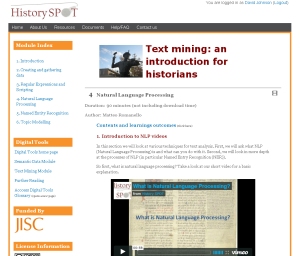![]() Two new inter-related free modules are now available on the History SPOT platform beginning a series on digital tools.
Two new inter-related free modules are now available on the History SPOT platform beginning a series on digital tools.
The first is about semantic mark-up – this is a beginner’s guide to marking up a text in XML so that it is searchable for information pertinent to historical research. Semantic mark-up is extremely common in History digital projects. Take for example the Old Bailey Proceedings Online or TAMO (The Acts and Monuments Online, otherwise known as the John Foxe Project). Both websites have marked up their texts so that you can find specific persons, places, and types of information from an index or via a search engine. Our module will guide you from beginning to end of that process from the starting point of no knowledge whatsoever (beyond some basic knowledge of using computers).
The same is true for the second module, on the topic of text mining. Where semantic mark-up enables you to find ![]() known information more easily, text mining gives you the opportunity to add additional structure to unstructured text (or texts) to enable research on relationships otherwise difficult to identify. For example, text mining would enable you to explore a large body of text, such as the Old Bailey records, and ask questions about associations: does, for example, mention of wine or beer appear most often with acts of violence or illness? You would presume it does, but text mining will allow you to confirm that fact.
known information more easily, text mining gives you the opportunity to add additional structure to unstructured text (or texts) to enable research on relationships otherwise difficult to identify. For example, text mining would enable you to explore a large body of text, such as the Old Bailey records, and ask questions about associations: does, for example, mention of wine or beer appear most often with acts of violence or illness? You would presume it does, but text mining will allow you to confirm that fact.
Now, text mining is undoubtedly a more specialist tool and to use it properly requires some extensive technical expertise. Our module tries to introduce you to the subject lightly and builds upon the training given for semantic mark-up. Beginners should be able to work their way through the module and understand what they are being asked to do and why. The module won’t tell you everything there is to know about text mining, nor will it train you in using development tools (although it will show you where you can go to get some basic knowledge on these). What it will do is show you what is involved and what you might get out of it before taking extensive time to learn the tools in-depth.
In addition to these two digital tools training modules, we have a tool audit (a list of various digital tools with a little introductory information) and a series of case studies. These are on the topics of semantic data, text mining, visualisation, linked data, and cloud computing.
These training materials are all outcomes from the JISC funded HISTORE project. For more details of that project please visit the HISTORE Blog and the Digital Skills workshop podcasts on History SPOT.

